SLAS396D July 2003 – November 2016 MSP430FE423 , MSP430FE425 , MSP430FE427
PRODUCTION DATA.
- 1Device Overview
- 2Revision History
- 3Device Comparison
- 4Terminal Configuration and Functions
-
5Specifications
- 5.1 Absolute Maximum Ratings
- 5.2 ESD Ratings
- 5.3 Recommended Operating Conditions
- 5.4 Supply Current Into AVCC and DVCC Excluding External Current
- 5.5 Thermal Resistance Characteristics, PM Package (LQFP64)
- 5.6 Schmitt-Trigger Inputs − Ports (P1 and P2), RST/NMI, JTAG (TCK, TMS, TDI/TCLK,TDO/TDI)
- 5.7 Inputs P1.x, P2.x, TAx
- 5.8 Leakage Current − Ports (P1 and P2)
- 5.9 Outputs − Ports (P1 and P2)
- 5.10 Output Frequency
- 5.11 Typical Characteristics - Ports P1 and P2
- 5.12 Wake-up Time From LPM3
- 5.13 RAM
- 5.14 LCD
- 5.15 USART0
- 5.16 POR, BOR
- 5.17 SVS (Supply Voltage Supervisor and Monitor)
- 5.18 DCO
- 5.19 Crystal Oscillator, LFXT1 Oscillator
- 5.20 ESP430CE1, SD16 and ESP430 Power Supply and Operating Conditions
- 5.21 ESP430CE1, SD16 Input Range
- 5.22 ESP430CE1, SD16 Performance
- 5.23 ESP430CE1, SD16 Temperature Sensor
- 5.24 ESP430CE1, SD16 Built-in Voltage Reference
- 5.25 ESP430CE1, SD16 Reference Output Buffer
- 5.26 ESP430CE1, SD16 External Reference Input
- 5.27 ESP430CE1, Active Energy Measurement Test Conditions and Accuracy
- 5.28 ESP430CE1, Active Energy Measurement Test Conditions and Accuracy
- 5.29 ESP430CE1 Typical Characteristics (I1 SD16GAINx = 1)
- 5.30 ESP430CE1 Typical Characteristics (I1 SD16GAINx = 4)
- 5.31 ESP430CE1 Typical Characteristics (I1 SD16GAINx = 8)
- 5.32 ESP430CE1 Typical Characteristics (I1 SD16GAINx = 32)
- 5.33 Flash Memory
- 5.34 JTAG Interface
- 5.35 JTAG Fuse
-
6Detailed Description
- 6.1 CPU
- 6.2 Instruction Set
- 6.3 Operating Modes
- 6.4 Interrupt Vector Addresses
- 6.5 Special Function Registers
- 6.6 Memory Organization
- 6.7 Bootloader (BSL)
- 6.8 Flash Memory
- 6.9 Peripherals
- 6.10
Input/Output Diagrams
- 6.10.1 Port P1 (P1.0 and P1.1) Input/Output With Schmitt Trigger
- 6.10.2 Port P1 (P1.2 to P1.7) Input/Output With Schmitt Trigger
- 6.10.3 Port P2 (P2.0 and P2.1) Input/Output With Schmitt Trigger
- 6.10.4 Port P2 (P2.2 to P2.5) Input/Output With Schmitt Trigger
- 6.10.5 Port P2 (P2.6 and P2.7) Unbonded GPIOs
- 6.10.6 JTAG Pins TMS, TCK, TDI/TCLK, TDO/TDI, Input/Output With Schmitt-Trigger or Output
- 6.10.7 JTAG Fuse Check Mode
- 7Device and Documentation Support
- 8Mechanical, Packaging, and Orderable Information
Package Options
Mechanical Data (Package|Pins)
- PM|64
Thermal pad, mechanical data (Package|Pins)
Orderable Information
6 Detailed Description
6.1 CPU
The MSP430 CPU has a 16-bit RISC architecture that is highly transparent to the application. All operations, other than program-flow instructions, are performed as register operations in conjunction with seven addressing modes for source operand and four addressing modes for destination operand.
The CPU is integrated with 16 registers that provide reduced instruction execution time. The register-to-register operation execution time is one cycle of the CPU clock.
Four of the registers, R0 to R3, are dedicated as program counter, stack pointer, status register, and constant generator, respectively. The remaining registers are general-purpose registers (see Figure 6-1).
Peripherals are connected to the CPU using data, address, and control buses. Peripherals can be manged with all instructions.
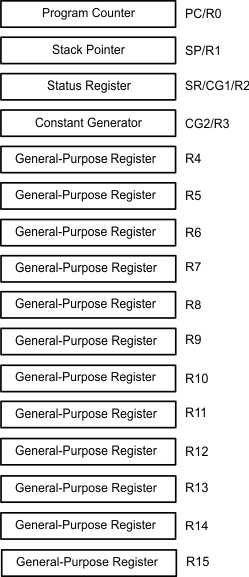 Figure 6-1 CPU Registers
Figure 6-1 CPU Registers
6.2 Instruction Set
The instruction set consists of the original 51 instructions with three formats and seven address modes. Each instruction can operate on word and byte data. Table 6-1 lists examples of the three types of instruction formats; Table 6-2 lists the address modes.
Table 6-1 Instruction Word Formats
| INSTRUCTION FORMAT | EXAMPLE | OPERATION | |
|---|---|---|---|
| Dual operands, source and destination | ADD | R4,R5 | R4 + R5 → R5 |
| Single operand, destination only | CALL | R8 | PC→(TOS), R8 →PC |
| Relative jump, unconditional or conditional | JNE | Jump-on-equal bit = 0 | |
Table 6-2 Address Mode Descriptions
| ADDRESS MODE | S(1) | D(1) | SYNTAX | EXAMPLE | OPERATION |
|---|---|---|---|---|---|
| Register | ● | ● | MOV Rs, Rd | MOV R10, R11 | R10 → R11 |
| Indexed | ● | ● | MOV X(Rn), Y(Rm) | MOV 2(R5), 6(R6) | M(2+R5)→ M(6+R6) |
| Symbolic (PC relative) | ● | ● | MOV EDE, TONI | M(EDE) → M(TONI) | |
| Absolute | ● | ● | MOV & MEM, & TCDAT | M(MEM) → M(TCDAT) | |
| Indirect | ● | MOV @Rn, Y(Rm) | MOV @R10, Tab(R6) | M(R10) → M(Tab+R6) | |
| Indirect autoincrement | ● | MOV @Rn+, Rm | MOV @R10+, R11 | M(R10) → R11 R10 + 2→ R10 |
|
| Immediate | ● | MOV #X, TONI | MOV #45, TONI | #45 → M(TONI) |
6.3 Operating Modes
The MSP430FE42x has one active mode and five software-selectable low-power modes of operation. An interrupt event can wake up the device from any of the five low-power modes, service the request, and restore back to the low-power mode on return from the interrupt program.
Software can configure the following operating modes:
- Active mode (AM)
- All clocks are active.
- Low-power mode 0 (LPM0)
- CPU is disabled.
- ACLK and SMCLK remain active, MCLK available to modules.
- FLL+ loop control remains active.
- Low-power mode 1 (LPM1)
- CPU is disabled.
- ACLK and SMCLK remain active, MCLK available to modules.
- FLL+ loop control is disabled.
- Low-power mode 2 (LPM2)
- CPU is disabled.
- MCLK, FLL+ loop control, and DCOCLK are disabled.
- DC generator of the DCO remains enabled.
- ACLK remains active.
- Low-power mode 3 (LPM3)
- CPU is disabled.
- MCLK, FLL+ loop control, and DCOCLK are disabled.
- DC generator of the DCO is disabled.
- ACLK remains active.
- Low-power mode 4 (LPM4)
- CPU is disabled.
- ACLK is disabled.
- MCLK, FLL+ loop control, and DCOCLK are disabled.
- DC generator of the DCO is disabled.
- Crystal oscillator is stopped.
6.4 Interrupt Vector Addresses
The interrupt vectors and the power-up starting address are in the address range 0FFFFh to 0FFE0h. The vector contains the 16-bit address of the appropriate interrupt-handler instruction sequence. Table 6-3 lists the interrupt sources, flags, and vectors.
Table 6-3 Interrupt Sources, Flags, and Vectors
| INTERRUPT SOURCE | INTERRUPT FLAG | SYSTEM INTERRUPT | WORD ADDRESS | PRIORITY |
|---|---|---|---|---|
| Power up External reset Watchdog Flash memory PC out of range(4) |
WDTIFG KEYV(1) |
Reset | 0FFFEh | 15, highest |
| NMI oscillator fault Flash memory access violation |
NMIIFG(1)
OFIFG(1) ACCVIFG(1) |
(Non)maskable(3)
(Non)maskable (Non)maskable |
0FFFCh | 14 |
| ESP430 | MBCTL_OUTxIFG, MBCTL_INxIFG(1)(2) | Maskable | 0FFFAh | 13 |
| SD16 | SD16CCTLx SD16OVIFG, SD16CCTLx SD16IFG(1)(2) |
Maskable | 0FFF8h | 12 |
| 0FFF6h | 11 | |||
| Watchdog timer | WDTIFG | Maskable | 0FFF4h | 10 |
| USART0 receive | URXIFG0 | Maskable | 0FFF2h | 9 |
| USART0 transmit | UTXIFG0 | Maskable | 0FFF0h | 8 |
| 0FFEEh | 7 | |||
| Timer_A3 | TACCR0 CCIFG(2) | Maskable | 0FFECh | 6 |
| Timer_A3 | TACCR1 and TACCR2 CCIFGs, and TACTL TAIFG(1)(2) |
Maskable | 0FFEAh | 5 |
| I/O port P1 (8 flags) | P1IFG.0 to P1IFG.7(1)(2) | Maskable | 0FFE8h | 4 |
| 0FFE6h | 3 | |||
| 0FFE4h | 2 | |||
| I/O port P2 (8 flags) | P2IFG.0 to P2IFG.7(1)(2) | Maskable | 0FFE2h | 1 |
| Basic Timer1 | BTIFG | Maskable | 0FFE0h | 0, lowest |
6.5 Special Function Registers
Most interrupt and module-enable bits are collected in the lowest address space. Special-function register bits not allocated to a functional purpose are not physically present in the device. This arrangement provides simple software access.
| Legend | ||
| rw | Bit can be read and written. | |
| rw-0, rw-1 | Bit can be read and written. It is reset or set by PUC. | |
| rw-(0), rw-(1) | Bit can be read and written. It is reset or set by POR. | |
| SFR bit is not present in device. | ||
Figure 6-2 shows the Interrupt Enable Register 1, and Table 6-4 describes the bit fields.
| 7 | 6 | 5 | 4 | 3 | 2 | 1 | 0 |
| UTXIE0 | URXIE0 | ACCVIE | NMIIE | OFIE | WDTIE | ||
| rw-0 | rw-0 | rw-0 | rw-0 | rw-0 | rw-0 |
Table 6-4 Interrupt Enable Register 1 Description
| BIT | FIELD | TYPE | RESET | DESCRIPTION |
|---|---|---|---|---|
| 7 | UTXIE0 | RW | 0h | USART0: UART and SPI transmit interrupt enable |
| 6 | URXIE0 | RW | 0h | USART0: UART and SPI receive interrupt enable |
| 5 | ACCVIE | RW | 0h | Flash access violation interrupt enable |
| 4 | NMIIE | RW | 0h | (Non)maskable interrupt enable |
| 1 | OFIE | RW | 0h | Oscillator fault interrupt enable |
| 0 | WDTIE | RW | 0h | Watchdog timer interrupt enable. Inactive if watchdog mode is selected. Active if watchdog timer is configured in interval timer mode. |
Figure 6-3 shows the Interrupt Enable Register 2, and Table 6-5 describes the bit fields.
| 7 | 6 | 5 | 4 | 3 | 2 | 1 | 0 |
| BTIE | |||||||
| rw-0 |
Table 6-5 Interrupt Enable Register 2 Description
| BIT | FIELD | TYPE | RESET | DESCRIPTION |
|---|---|---|---|---|
| 7 | BTIE | RW | 0h | Basic Timer1 interrupt enable |
Figure 6-4 shows the Interrupt Flag Register 1, and Table 6-6 describes the bit fields.
| 7 | 6 | 5 | 4 | 3 | 2 | 1 | 0 |
| UTXIFG0 | URXIFG0 | NMIIFG | OFIFG | WDTIFG | |||
| rw-1 | rw-0 | rw-0 | rw-1 | rw-(0) |
Table 6-6 Interrupt Flag Register 1 Description
| BIT | FIELD | TYPE | RESET | DESCRIPTION |
|---|---|---|---|---|
| 7 | UTXIFG0 | RW | 1h | USART0: UART and SPI transmit flag |
| 6 | URXIFG0 | RW | 0h | USART0: UART and SPI receive flag |
| 4 | NMIIFG | RW | 0h | Set by the RST/NMI pin |
| 1 | OFIFG | RW | 1h | Flag set on oscillator fault. |
| 0 | WDTIFG | RW | 0h | Set on watchdog timer overflow (in watchdog mode) or security key violation. Reset on VCC power on or a reset condition at the RST/NMI pin in reset mode. |
Figure 6-5 shows the Interrupt Flag Register 2, and Table 6-7 describes the bit fields.
| 7 | 6 | 5 | 4 | 3 | 2 | 1 | 0 |
| BTIFG | |||||||
| rw-0 |
Table 6-7 Interrupt Flag Register 2 Description
| BIT | FIELD | TYPE | RESET | DESCRIPTION |
|---|---|---|---|---|
| 7 | BTIFG | RW | 0h | Basic Timer1 interrupt flag |
Figure 6-6 shows the Module Enable Register 1, and Table 6-8 describes the bit fields.
| 7 | 6 | 5 | 4 | 3 | 2 | 1 | 0 |
| UTXE0 | URXE0 USPIE0 |
||||||
| rw-0 | rw-0 |
Table 6-8 Module Enable Register 1 Description
| BIT | FIELD | TYPE | RESET | DESCRIPTION |
|---|---|---|---|---|
| 7 | UTXE0 | RW | 0h | USART0: UART mode transmit enable |
| 6 | URXE0 USPIE0 |
RW | 0h | USART0: UART mode receive enable USART0: SPI mode transmit and receive enable |
Module Enable Register 2 is not defined for the MSP430FE42x MCUs.
6.6 Memory Organization
Table 6-9 summarizes the memory map of the MSP430FE42x MCUs.
Table 6-9 Memory Organization
| MSP430FE423 | MSP430FE425 | MSP430FE427 | ||
|---|---|---|---|---|
| Memory | Size | 8KB | 16KB | 32KB |
| Interrupt vector | Flash | 0FFFFh–0FFE0h | 0FFFFh–0FFE0h | 0FFFFh–0FFE0h |
| Code memory | Flash | 0FFFFh–0E000h | 0FFFFh–0C000h | 0FFFFh–08000h |
| Information memory | Size | 256 Byte | 256 Byte | 256 Byte |
| 010FFh–01000h | 010FFh–01000h | 010FFh–01000h | ||
| Boot memory | Size | 1KB | 1KB | 1KB |
| 0FFFh–0C00h | 0FFFh–0C00h | 0FFFh–0C00h | ||
| RAM | Size | 256 Byte | 512 Byte | 1KB |
| 02FFh–0200h | 03FFh–0200h | 05FFh–0200h | ||
| Peripherals | 16-bit | 01FFh–0100h | 01FFh–0100h | 01FFh–0100h |
| 8-bit | 0FFh–010h | 0FFh–010h | 0FFh–010h | |
| 8-bit SFR | 0Fh–00h | 0Fh–00h | 0Fh–00h | |
6.7 Bootloader (BSL)
The MSP430 bootloader (BSL) enables users to program the flash memory or RAM using a UART serial interface. Access to the MSP430 memory through the BSL is protected by user-defined password. For complete description of the features of the BSL and its implementation, see MSP430 Programming WIth the Bootloader (BSL).
| BSL FUNCTION | PM PACKAGE PINS |
|---|---|
| Data transmit | 53 - P1.0 |
| Data receiver | 52 - P1.1 |
6.8 Flash Memory
The flash memory (see Figure 6-7) can be programmed using the JTAG port, the bootloader, or in system by the CPU. The CPU can perform single-byte and single-word writes to the flash memory. Features of the flash memory include:
- Flash memory has n segments of main memory and two segments of information memory (A and B) of 128 bytes each. Each segment in main memory is 512 bytes in size.
- Segments 0 to n may be erased in one step, or each segment may be individually erased.
- Segments A and B can be erased individually, or as a group with segments 0 to n. Segments A and B are also called information memory.
- New devices may have some bytes programmed in the information memory (needed for test during manufacturing). The user should perform an erase of the information memory before the first use.
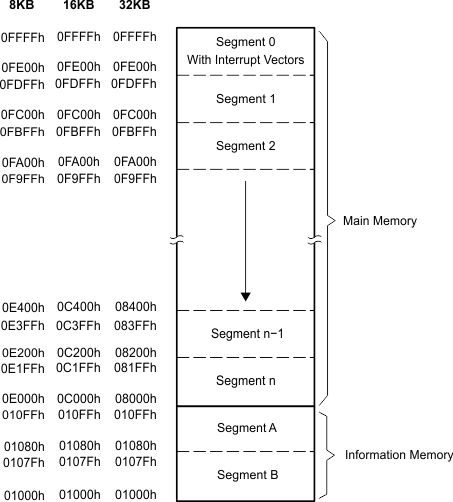 Figure 6-7 Flash Memory Map
Figure 6-7 Flash Memory Map
6.9 Peripherals
Peripherals are connected to the CPU through data, address, and control buses. Peripherals can be managed using all instructions. For complete module descriptions, see the MSP430x4xx Family User's Guide.
6.9.1 Oscillator and System Clock
The clock system is supported by the FLL+ module that includes support for a 32768-Hz watch crystal oscillator, an internal digitally controlled oscillator (DCO), and a high-frequency crystal oscillator. The FLL+ clock module is designed to meet the requirements of both low system cost and low power consumption. The FLL+ features digital frequency locked loop (FLL) hardware that, in conjunction with a digital modulator, stabilizes the DCO frequency to a programmable multiple of the watch crystal frequency. The internal DCO provides a fast turnon clock source and stabilizes in less than 6 µs. The FLL+ module provides the following clock signals:
- Auxiliary clock (ACLK), sourced from a 32768-Hz watch crystal or a high-frequency crystal
- Main clock (MCLK), the system clock used by the CPU
- Sub-Main clock (SMCLK), the subsystem clock used by the peripheral modules
- ACLK/n, the buffered output of ACLK, ACLK/2, ACLK/4, or ACLK/8
6.9.2 Brownout, Supply Voltage Supervisor (SVS)
The brownout circuit provides the proper internal reset signal to the device during power on and power off. The SVS circuitry detects if the supply voltage drops below a user-selectable level and supports both supply voltage supervision (the device is automatically reset) and supply voltage monitoring (the device is not automatically reset).
The CPU begins code execution after the brownout circuit releases the device reset. However, VCC may not have ramped to VCC(min) at that time. The user must ensure that the default FLL+ settings are not changed until VCC reaches VCC(min). If desired, the SVS circuit can be used to determine when VCC reaches VCC(min).
6.9.3 Digital I/O
Two I/O ports are implemented: ports P1 and P2 (only six P2 I/O signals are available on external pins).
- All individual I/O bits are independently programmable.
- Any combination of input, output, and interrupt conditions is possible.
- Edge-selectable interrupt input capability for all the eight bits of ports P1 and P2.
- Read/write access to port-control registers is supported by all instructions.
NOTE
Six bits of port P2 (P2.0 to P2.5) are available on external pins, but all control and data bits for port P2 are implemented.
6.9.4 Basic Timer1
The Basic Timer1 has two independent 8-bit timers that can be cascaded to form a 16-bit timer/counter. Both timers can be read and written by software. The Basic Timer1 can be used to generate periodic interrupts and clock for the LCD module.
6.9.5 LCD Drive
The LCD driver generates the segment and common signals required to drive an LCD display. The LCD controller has dedicated data memory to hold segment drive information. Common and segment signals are generated as defined by the mode. Static, 2-mux, 3-mux, and 4-mux LCDs are supported by this peripheral.
6.9.6 Watchdog Timer (WDT+)
The primary function of the WDT+ module is to perform a controlled system restart after a software problem occurs. If the selected time interval expires, a system reset is generated. If the watchdog function is not needed in an application, the module can be configured as an interval timer and can generate interrupts at selected time intervals.
6.9.7 Timer_A3
Timer_A3 is a 16-bit timer and counter with three capture/compare registers. Timer_A3 can support multiple capture/compares, PWM outputs, and interval timing (see Table 6-10). Timer_A3 also has extensive interrupt capabilities. Interrupts may be generated from the counter on overflow conditions and from each of the capture/compare registers.
Table 6-10 Timer_A3 Signal Connections
| INPUT PIN NUMBER | DEVICE INPUT SIGNAL | MODULE INPUT NAME | MODULE BLOCK | MODULE OUTPUT SIGNAL | OUTPUT PIN NUMBER |
|---|---|---|---|---|---|
| 48 - P1.5 | TACLK | TACLK | Timer | NA | |
| ACLK | ACLK | ||||
| SMCLK | SMCLK | ||||
| 48 - P1.5 | TACLK | INCLK | |||
| 53 - P1.0 | TA0 | CCI0A | CCR0 | TA0 | 53 - P1.0 |
| 52 - P1.1 | TA0 | CCI0B | |||
| DVSS | GND | ||||
| DVCC | VCC | ||||
| 51 - P1.2 | TA1 | CCI1A | CCR1 | TA1 | 51 - P1.2 |
| 51 - P1.2 | TA1 | CCI1B | |||
| DVSS | GND | ||||
| DVCC | VCC | ||||
| 45 - P2.0 | TA2 | CCI2A | CCR2 | TA2 | 45 - P2.0 |
| ACLK (internal) | CCI2B | ||||
| DVSS | GND | ||||
| DVCC | VCC |
6.9.8 USART0
The MSP430FE42x devices have one hardware universal synchronous/asynchronous receive transmit (USART0) peripheral module that is used for serial data communication. The USART supports synchronous SPI (3- or 4-pin) and asynchronous UART communication protocols, using double-buffered transmit and receive channels.
6.9.9 ESP430CE1
The ESP430CE1 module integrates a hardware multiplier, three independent 16-bit Sigma-Delta ADCs (SD16) and an embedded signal processor (ESP430). The ESP430CE1 module measures 2- or 3-wire single-phase energy and automatically calculates parameters which are made available to the MSP430 CPU. The module can be calibrated and initialized to accurately calculate energy, power factor, and other values for a wide range of metering sensor configurations.
6.9.10 Peripheral File Map
Table 6-11 and Table 6-12 list the peripheral registers with their addresses.
Table 6-11 Peripherals With Word Access
| MODULE | REGISTER NAME | ACRONYM | ADDRESS |
|---|---|---|---|
| Watchdog | Watchdog timer control | WDTCTL | 0120h |
| Timer_A3 | Timer0_A interrupt vector | TA0IV | 012Eh |
| Timer0_A control | TACTL0 | 0160h | |
| Capture/compare control 0 | TACCTL0 | 0162h | |
| Capture/compare control 1 | TACCTL1 | 0164h | |
| Capture/compare control 2 | TACCTL2 | 0166h | |
| Reserved | 0168h | ||
| Reserved | 016Ah | ||
| Reserved | 016Ch | ||
| Reserved | 016Eh | ||
| Timer_A counter | TA0R | 0170h | |
| Capture/compare 0 | TACCR0 | 0172h | |
| Capture/compare 1 | TACCR1 | 0174h | |
| Capture/compare 2 | TACCR2 | 0176h | |
| Reserved | 0178h | ||
| Reserved | 017Ah | ||
| Reserved | 017Ch | ||
| Reserved | 017Eh | ||
| Hardware Multiplier(1) | Sum extend | SUMEXT | 013Eh |
| Result high word | RESHI | 013Ch | |
| Result low word | RESLO | 013Ah | |
| Second operand | OP2 | 0138h | |
| Multiply signed + accumulate/operand 1 | MACS | 0136h | |
| Multiply + accumulate/operand 1 | MAC | 0134h | |
| Multiply signed/operand 1 | MPYS | 0132h | |
| Multiply unsigned/operand 1 | MPY | 0130h | |
| Flash | Flash control 3 | FCTL3 | 012Ch |
| Flash control 2 | FCTL2 | 012Ah | |
| Flash control 1 | FCTL1 | 0128h | |
| SD16(1)
(also see Table 6-12) |
General control | SD16CTL | 0100h |
| Channel 0 control | SD16CCTL0 | 0102h | |
| Channel 1 control | SD16CCTL1 | 0104h | |
| Channel 2 control | SD16CCTL2 | 0106h | |
| Reserved | 0108h | ||
| Reserved | 010Ah | ||
| Reserved | 010Ch | ||
| Reserved | 010Eh | ||
| Interrupt vector word | SD16IV | 0110h | |
| Channel 0 conversion memory | SD16MEM0 | 0112h | |
| Channel 1 conversion memory | SD16MEM1 | 0114h | |
| Channel 2 conversion memory | SD16MEM2 | 0116h | |
| Reserved | 0118h | ||
| Reserved | 011Ah | ||
| Reserved | 011Ch | ||
| Reserved | 011Eh | ||
| ESP430 (ESP430CE1) | ESP430 control | ESPCTL | 0150h |
| Mailbox control | MBCTL | 0152h | |
| Mailbox in 0 | MBIN0 | 0154h | |
| Mailbox in 1 | MBIN1 | 0156h | |
| Mailbox out 0 | MBOUT0 | 0158h | |
| Mailbox out 1 | MBOUT1 | 015Ah | |
| ESP430 return value 0 | RET0 | 01C0h | |
| ⋮ | ⋮ | ⋮ | |
| ESP430 return value 31 | RET31 | 01FEh |
Table 6-12 Peripherals With Byte Access
| MODULE | REGISTER NAME | ACRONYM | ADDRESS |
|---|---|---|---|
| SD16(1)
(also see Table 6-11) |
Channel 0 input control | SD16INCTL0 | 0B0h |
| Channel 1 input control | SD16INCTL1 | 0B1h | |
| Channel 2 input control | SD16INCTL2 | 0B2h | |
| Reserved | 0B3h | ||
| Reserved | 0B4h | ||
| Reserved | 0B5h | ||
| Reserved | 0B6h | ||
| Reserved | 0B7h | ||
| Channel 0 preload | SD16PRE0 | 0B8h | |
| Channel 1 preload | SD16PRE1 | 0B9h | |
| Channel 2 preload | SD16PRE2 | 0BAh | |
| Reserved | 0BBh | ||
| Reserved | 0BCh | ||
| Reserved | 0BDh | ||
| Reserved | 0BEh | ||
| Reserved | 0BFh | ||
| LCD | LCD memory 20 | LCDM20 | 0A4h |
| ⋮ | ⋮ | ⋮ | |
| LCD memory 16 | LCDM16 | 0A0h | |
| LCD memory 15 | LCDM15 | 09Fh | |
| ⋮ | ⋮ | ⋮ | |
| LCD memory 1 | LCDM1 | 091h | |
| LCD control and mode | LCDCTL | 090h | |
| USART0 | Transmit buffer | U0TXBUF | 077h |
| Receive buffer | U0RXBUF | 076h | |
| Baud rate 1 | U0BR1 | 075h | |
| Baud rate 0 | U0BR0 | 074h | |
| Modulation control | U0MCTL | 073h | |
| Receive control | U0RCTL | 072h | |
| Transmit control | U0TCTL | 071h | |
| USART control | U0CTL | 070h | |
| Brownout, SVS | SVS control register | SVSCTL | 056h |
| FLL+ Clock | FLL+ control 1 | FLL_CTL1 | 054h |
| FLL+ control 0 | FLL_CTL0 | 053h | |
| System clock frequency control | SCFQCTL | 052h | |
| System clock frequency integrator | SCFI1 | 051h | |
| System clock frequency integrator | SCFI0 | 050h | |
| Basic Timer1 | BT counter 2 | BTCNT2 | 047h |
| BT counter 1 | BTCNT1 | 046h | |
| BT control | BTCTL | 040h | |
| Port P2 | Port P2 selection | P2SEL | 02Eh |
| Port P2 interrupt enable | P2IE | 02Dh | |
| Port P2 interrupt-edge select | P2IES | 02Ch | |
| Port P2 interrupt flag | P2IFG | 02Bh | |
| Port P2 direction | P2DIR | 02Ah | |
| Port P2 output | P2OUT | 029h | |
| Port P2 input | P2IN | 028h | |
| Port P1 | Port P1 selection | P1SEL | 026h |
| Port P1 interrupt enable | P1IE | 025h | |
| Port P1 interrupt-edge select | P1IES | 024h | |
| Port P1 interrupt flag | P1IFG | 023h | |
| Port P1 direction | P1DIR | 022h | |
| Port P1 output | P1OUT | 021h | |
| Port P1 input | P1IN | 020h | |
| Special Functions | SFR module enable 2 | ME2 | 005h |
| SFR module enable 1 | ME1 | 004h | |
| SFR interrupt flag 2 | IFG2 | 003h | |
| SFR interrupt flag 1 | IFG1 | 002h | |
| SFR interrupt enable 2 | IE2 | 001h | |
| SFR interrupt enable 1 | IE1 | 000h |
6.10 Input/Output Diagrams
6.10.1 Port P1 (P1.0 and P1.1) Input/Output With Schmitt Trigger
Figure 6-8 shows the port diagram. Table 6-13 summarizes the selection of the port function.
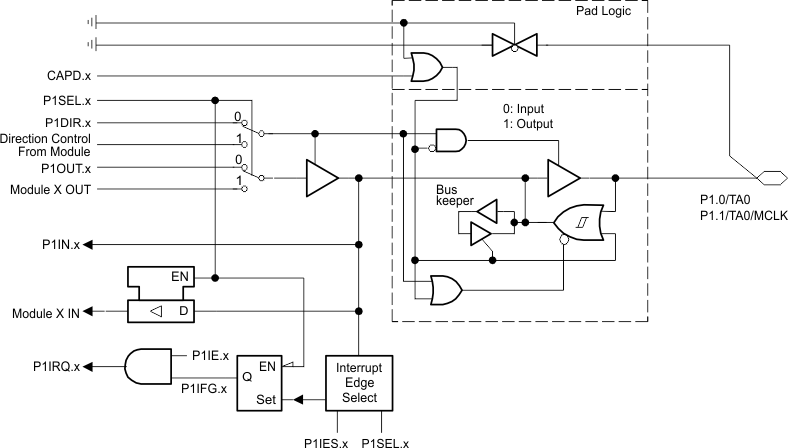
NOTE:
0 ≤ x ≤ 1. Port function is active if CAPD.x = 0.Table 6-13 Port P1 (P1.0 and P1.1) Pin Function
| P1SEL.x | PnDIR.x | DIRECTION CONTROL FROM MODULE | P1OUT.x | MODULE X OUT | P1IN.x | MODULE X IN | P1IE.x | P1IFG.x | P1IES.x | CAPD.x |
|---|---|---|---|---|---|---|---|---|---|---|
| P1SEL.0 | P1DIR.0 | P1DIR.0 | P1OUT.0 | Out0 Sig.(1) | P1IN.0 | CCI0A(1) | P1IE.0 | P1IFG.0 | P1IES.0 | DVSS |
| P1SEL.1 | P1DIR.1 | P1DIR.1 | P1OUT.1 | MCLK | P1IN.1 | CCI0B(1) | P1IE.1 | P1IFG.1 | P1IES.1 | DVSS |
6.10.2 Port P1 (P1.2 to P1.7) Input/Output With Schmitt Trigger
Figure 6-9 shows the port diagram. Table 6-14 summarizes the selection of the port function.
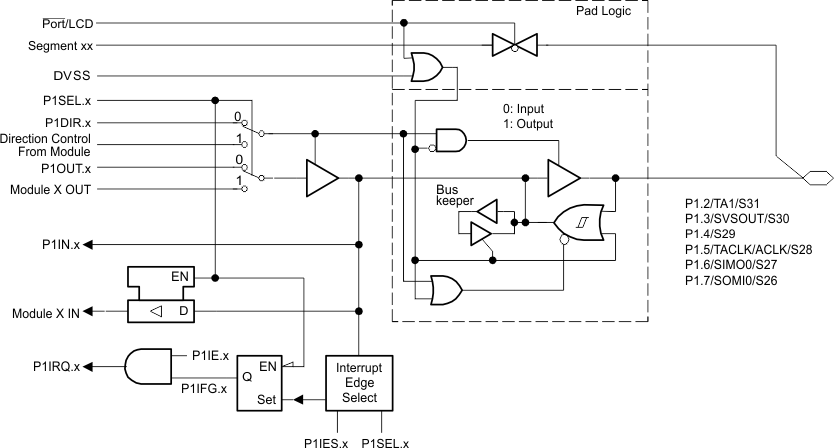
NOTE:
2 ≤ x ≤ 7. Port function is active if Port/LCD = 0.Table 6-14 Port P1 (P1.2 to P1.7) Pin Functions
| P1SEL.x | P1DIR.x | DIRECTION CONTROL FROM MODULE | P1OUT.x | MODULE X OUT | P1IN.x | MODULE X IN | P1IE.x | P1IFG.x | P1IES.x | Port/LCD | SEGMENT |
|---|---|---|---|---|---|---|---|---|---|---|---|
| P1SEL.2 | P1DIR.2 | P1DIR.2 | P1OUT.2 | Out1 Sig.(1) | P1IN.2 | CCI1A† | P1IE.2 | P1IFG.2 | P1IES.2 | 0: LCDPx < 05h, 1: LCDPx ≥ 05h |
S31 |
| P1SEL.3 | P1DIR.3 | P1DIR.3 | P1OUT.3 | SVSOUT | P1IN.3 | unused | P1IE.3 | P1IFG.3 | P1IES.3 | S30 | |
| P1SEL.4 | P1DIR.4 | P1DIR.4 | P1OUT.4 | DVSS | P1IN.4 | unused | P1IE.4 | P1IFG.4 | P1IES.4 | S29 | |
| P1SEL.5 | P1DIR.5 | P1DIR.5 | P1OUT.5 | ACLK | P1IN.5 | TACLK(1) | P1IE.5 | P1IFG.5 | P1IES.5 | S28 | |
| P1SEL.6 | P1DIR.6 | DCM_SIMO | P1OUT.6 | SIMO0(o)(2) | P1IN.6 | SIMO0(i)(2) | P1IE.6 | P1IFG.6 | P1IES.6 | 0: LCDPx < 04h, 1: LCDPx ≥ 04h |
S27 |
| P1SEL.7 | P1DIR.7 | DCM_SOMI | P1OUT.7 | SOMI0(o)(2) | P1IN.7 | SOMI0(i)(2) | P1IE.7 | P1IFG.7 | P1IES.7 | S26 |
 Figure 6-10 Direction Control for SIMO0 and SOMI0
Figure 6-10 Direction Control for SIMO0 and SOMI0
6.10.3 Port P2 (P2.0 and P2.1) Input/Output With Schmitt Trigger
Figure 6-11 shows the port diagram. Table 6-15 summarizes the selection of the port function.
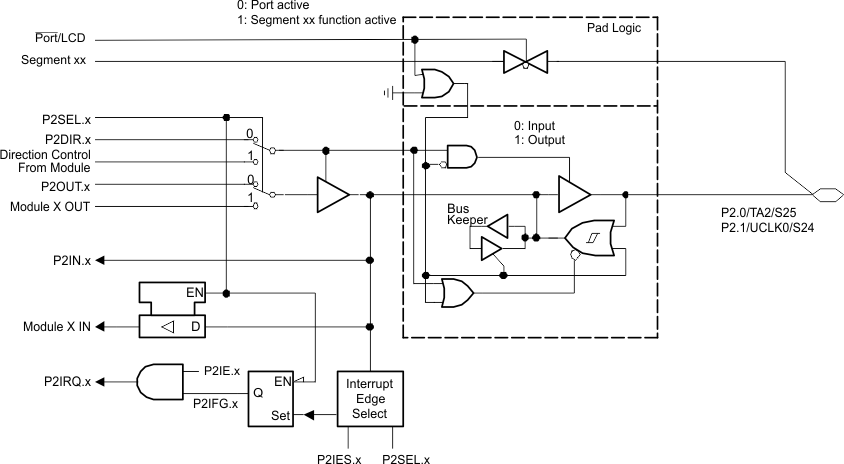
NOTE:
0 ≤ x ≤ 1. Port function is active if Port/LCD = 0.Table 6-15 Port P2 (P2.0 and P2.1) Pin Functions
| P2SEL.x | P2DIR.x | DIRECTION CONTROL FROM MODULE | P2OUT.x | MODULE X OUT | P2IN.x | MODULE X IN | P2IE.x | P2IFG.x | P2IES.x | Port/LCD | SEGMENT |
|---|---|---|---|---|---|---|---|---|---|---|---|
| P2SEL.0 | P2DIR.0 | P2DIR.0 | P2OUT.0 | Out2 Sig.(1) | P2IN.0 | CCI2A(1) | P2IE.0 | P2IFG.0 | P2IES.0 | 0: LCDPx < 04h, 1: LCDPx ≥ 04h |
S25 |
| P2SEL.1 | P2DIR.1 | DCM_UCLK | P2OUT.1 | UCLK0(o)(2) | P2IN.1 | UCLK0(i)(2) | P2IE.1 | P2IFG.1 | P2IES.1 | S24 |
 Figure 6-12 Direction Control for UCLK0
Figure 6-12 Direction Control for UCLK0
6.10.4 Port P2 (P2.2 to P2.5) Input/Output With Schmitt Trigger
Figure 6-13 shows the port diagram. Table 6-16 summarizes the selection of the port function.
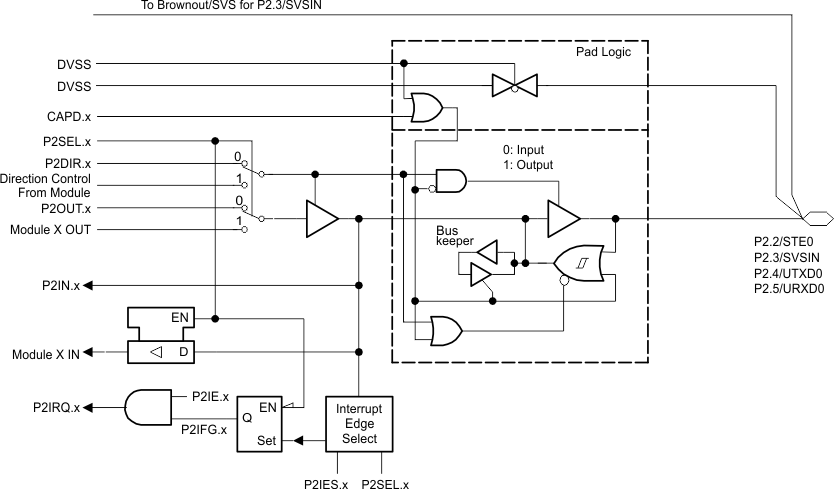
NOTE:
2 ≤ x ≤ 5. Port function is active if CAPD.x = 0Table 6-16 Port P2 (P2.2 to P2.5) Pin Functions
| P2SEL.x | P2DIR.x | DIRECTION CONTROL FROM MODULE | P2OUT.x | MODULE X OUT | P2IN.x | MODULE X IN | P2IE.x | P2IFG.x | P2IES.x | CAPD.x |
|---|---|---|---|---|---|---|---|---|---|---|
| P2SEL.2 | P2DIR.2 | DVSS | P2OUT.2 | DVSS | P2IN.2 | STE0(1) | P2IE.2 | P2IFG.2 | P2IES.2 | DVSS |
| P2SEL.3 | P2DIR.3 | P2DIR.3 | P2OUT.3 | DVSS | P2IN.3 | Unused | P2IE.3 | P2IFG.3 | P2IES.3 | SVSCTL VLD = 1111b |
| P2SEL.4 | P2DIR.4 | DVCC | P2OUT.4 | UTXD0(1) | P2IN.4 | Unused | P2IE.4 | P2IFG.4 | P2IES.4 | DVSS |
| P2SEL.5 | P2DIR.5 | DVSS | P2OUT.5 | DVSS | P2IN.5 | URXD0(1) | P2IE.5 | P2IFG.5 | P2IES.5 | DVSS |
6.10.5 Port P2 (P2.6 and P2.7) Unbonded GPIOs
Unbonded GPIOs P2.6 and P2.7 can be used as interrupt flags. Only software can affect the interrupt flags. They work as software interrupts.
Figure 6-14 shows the port diagram. Table 6-17 summarizes the selection of the port function.
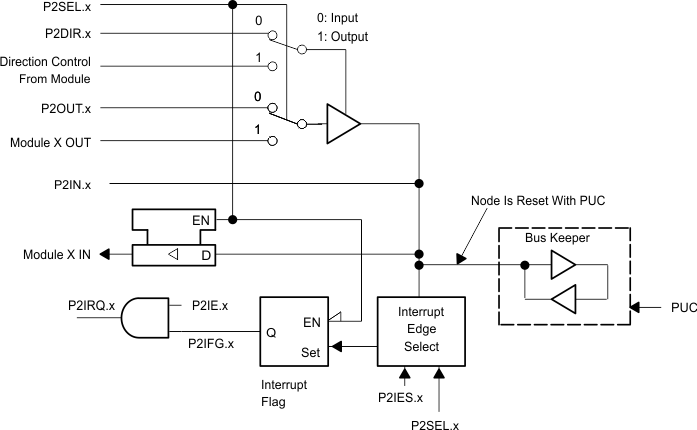
NOTE:
x = Bit/identifier, 6 or 7 for Port P2 without external pinsTable 6-17 Port P2 (P2.6 and P2.7) Pin Functions
| P2SEL.x | P2DIR.x | DIRECTION CONTROL FROM MODULE | P2OUT.x | MODULE X OUT | P2IN.x | MODULE X IN | P2IE.x | P2IFG.x | P2IES.x |
|---|---|---|---|---|---|---|---|---|---|
| P2SEL.6 | P2DIR.6 | P2DIR.6 | P2OUT.6 | DVSS | P2IN.6 | Unused | P2IE.6 | P2IFG.6 | P2IES.6 |
| P2SEL.7 | P2DIR.7 | P2DIR.7 | P2OUT.7 | DVSS | P2IN.7 | Unused | P2IE.7 | P2IFG.7 | P2IES.7 |
6.10.6 JTAG Pins TMS, TCK, TDI/TCLK, TDO/TDI, Input/Output With Schmitt-Trigger or Output
Figure 6-15 shows the port diagram.
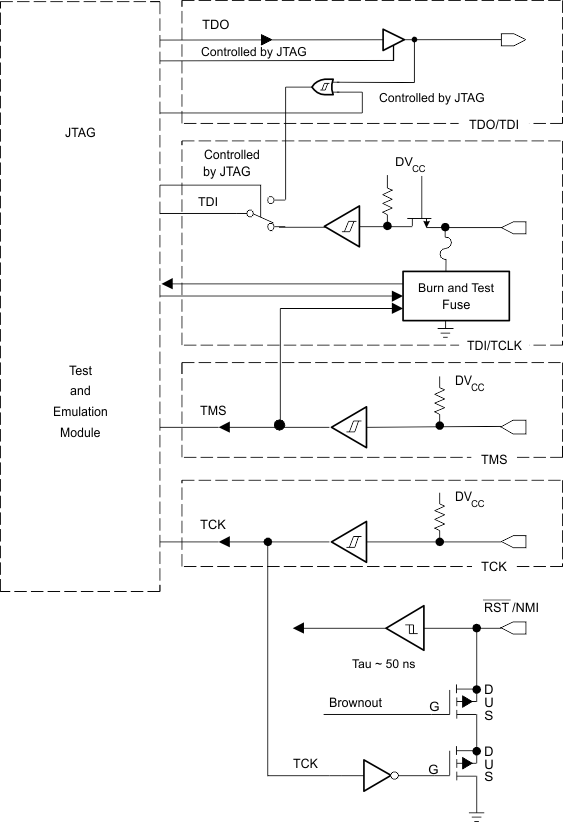 Figure 6-15 JTAG Pins Diagram
Figure 6-15 JTAG Pins Diagram
6.10.7 JTAG Fuse Check Mode
MSP430 devices that have the fuse on the TDI/TCLK terminal have a fuse check mode that tests the continuity of the fuse the first time the JTAG port is accessed after a power-on reset (POR). When activated, a fuse check current (I(TF)) of 1.8 mA at 3 V can flow from the TDI/TCLK pin to ground if the fuse is not burned. Care must be taken to avoid accidentally activating the fuse check mode and increasing overall system power consumption.
Activation of the fuse check mode occurs with the first negative edge on the TMS pin after power up or if the TMS is being held low during power up. The second positive edge on the TMS pin deactivates the fuse check mode. After deactivation, the fuse check mode remains inactive until another POR occurs. After each POR the fuse check mode has the potential to be activated.
The fuse check current flows only when the fuse check mode is active and the TMS pin is in a low state (see Figure 6-16). Therefore, the additional current flow can be prevented by holding the TMS pin high (default condition). The JTAG pins are terminated internally and therefore do not require external termination.
 Figure 6-16 Fuse Check Mode Current
Figure 6-16 Fuse Check Mode Current